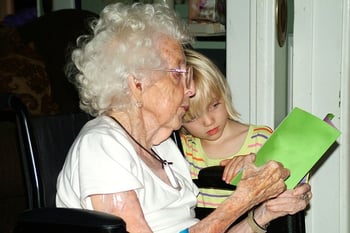As time marches on, we in long-term care and senior living find ourselves adjusting as best we can to a new (and thankfully temporary) normal. This is definitely true for those working in communities, fighting to keep their residents safe and healthy...and engaged.
Among the most common challenges we’re seeing from communities is how to maintain resident engagement and morale during this time of serious COVID-19 proximity restrictions. We’ve surfed the web a bit and borrowed from others’ lists to bring you this quick group of resources appropriate for our audience. Here’s hoping you find some gems for your residents!
Industry Resources
- Free Programming Ideas and Resources from the National Association of Activities Professionals.
- Resident Engagement During Social Isolation – ideas shared by LeadingAge members.
- Free printables, Quaran-tunes, Print-to-Paint images and more from It’s Never 2 Late.
- Free resources organized by category from Touchtown, One Day U, Eversound, Brilliant Age, CareGrove, and Total Brain Health.
- Tips for One-on-One and Small Group Activities from Alzheimer’s Care Group.
- Resident Engagement in Memory Care from California Assisted Living Association
Museums
- The Louvre: You don't have to book a ticket to Paris to check out some of the famous pieces in the world's largest art museum. The Louvre has free online tours of three famous exhibits, including Egyptian Antiquities.
- Solomon R. Guggenheim Museum: The works of Pablo Picasso, Piet Mondrian, Jeff Koons, and Franz Marc are just some of the 625 artists whose work are a part of the Guggenheim's Collection Online.
- Smithsonian National Museum of Natural History: Move at your own pace through the 360-degree room-by-room tour of every exhibit in the museum.
- Van Gogh Museum: You can get up close and personal with the impressionist painter's most famous work thanks to Google Arts & Culture.
- Getty Museum: Los Angeles's premiere gallery has two virtual tours, including "Eat, Drink, and Be Merry," which is a closer look at food in the Middle Ages and Renaissance.
- The Vatican Museum: The Sistine Chapel, St. Peter's Basilica, and Raphael's Room, are just some of the sites you can see on the Vatican's virtual tour.
- Thyssen-Bornemisza Museum: Madrid's must-see art museum has the works of some of the continent's most celebrated artists like Rembrandt and Dali available online.
- Georgia O’Keeffe Museum: Six virtual exhibits are available online from this museum named for the "Mother of American modernism."
- National Museum of Anthropology, Mexico City: Dive into the pre-Hispanic history of Mexico with 23 exhibit rooms full of Mayan artifacts.
- British Museum, London: The Rosetta Stone and Egyptian mummies are just a couple of things that you're able to see on a virtual tour of the museum.
- NASA: Both Virginia's Langley Research Center and Ohio's Glenn Research Center offer online tours for free. Also, you can try some "augmented reality experiences" via The Space Center Houston's app.
- National Women's History Museum: Have a late International Women's Day celebration with online exhibits and oral histories from the Virginia museum.
- Metropolitan Museum of Art: Though the Met Gala was cancelled this year, you can still have a peak at the The Costume Institute Conversation Lab, which is one of the institution's 26 online exhibits.
- High Museum of Art, Atlanta: This museum's popular online exhibits include "Civil Rights Photography" — photos that capture moments of social protest like the Freedom Rides and Rosa Park's arrest.
- Detroit Institute of Arts: Mexican art icon Frida Kahlo is the focal point of two of the four available online exhibits.
- Rijksmuseum, Amsterdam: The Golden Age of Dutch art is highlighted in this museum which includes the work of Vermeer and Rembrandt.
- National Museum of the United States Air Force: You can't take a ride in Franklin D. Roosevelt's presidential airplane, but you can check it out, in addition to other military weapons and aircraft, online in the Air Force's official museum.
- MoMA (The Museum of Modern Art): New York's extensive collection is available for view online.
- More Museum Ideas:
- The Colosseum
- Great Wall of China
- Pyramids of Giza
- National Portrait Gallery
- Highlights from the American Museum of Natural History
 Queensland Museum Virtual Tour, Australia
Queensland Museum Virtual Tour, Australia- Anne Frank House Secret Annex, Amsterdam
- Interactive Tour of Ellis Island, New York
- Pompeii, Italy (From Google Street View – SO cool!)
Zoos and Aquariums
- The Cincinnati Zoo: Check in around 3 p.m., because that's the time the Zoo holds a daily Home Safari on its Facebook Live Feed.
- Atlanta Zoo: The Georgia zoo keeps a "Panda Cam" livestream on its website.
- Georgia Aquarium: Sea-dwellers like African penguins and Beluga Whales are the stars of this aquarium's live cam.
- Houston Zoo: There are plenty of different animals you can check in on with this zoo's live cam, but we highly recommend watching the playful elephants.
- The Shedd Aquarium: This Chicago aquarium shares some pretty adorable behind-the-scenes footage of their residents on Facebook.
- San Diego Zoo: With what may be the most live cam options, this zoo lets you switch between koalas, polar bears, and tigers in one sitting.
- Monterey Bay Aquarium: It can be Shark Week every week thanks to live online footage of Monterey Bay's Habitat exhibit.
- National Aquarium: Walk through tropical waters to the icy tundra in this floor-b
- y-floor tour of the famous, Baltimore-based aquarium.
Theme Parks
- Walt Disney World: Set aside some time, because there's plenty to see here. Virtual tours you can take include Magic Kingdom, Animal Kingdom, and Epcot, just to name a few. There are also unofficial YouTube videos that feel just like you're on famous rides like the Frozen Ever After ride, It's a Small World, Monsters, Inc. Mike & Sulley to the Rescue!, and Pirates of the Caribbean.
- LEGOLAND Florida Resort: The Great Lego Race and Miniland USA are just
two of the attractions you can check out in a virtual tour of the park. - SeaWorld Orlando: The virtual tour of Seaworld includes a tour of Discovery Cove and the option to"ride" the steel roller coaster Mako.
For a printable PDF of this list, just click here.


 A
A 
 Generations United and LeadingAge that distills the results of a year-long study on the nature and extent of intergeneration programming in senior housing.
Generations United and LeadingAge that distills the results of a year-long study on the nature and extent of intergeneration programming in senior housing.

 according to a panel convened recently at the
according to a panel convened recently at the